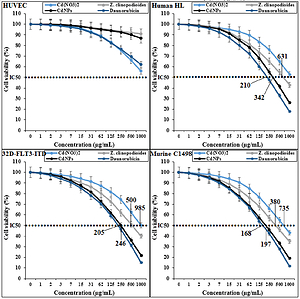Current issue
Archive
Manuscripts accepted
About the Journal
Editorial office
Editorial board
Section Editors
Abstracting and indexing
Subscription
Contact
Ethical standards and procedures
Most read articles
Instructions for authors
Article Processing Charge (APC)
Regulations of paying article processing charge (APC)
HEMATOLOGY / BASIC RESEARCH
Anti-leukemia properties of cadmium nanoparticles in in vitro and in vivo conditions: a chemobiological study
1
Department of Hematology, Shaanxi Provincial People’s Hospital, Beilin District, Xi’an City, Shaanxi Province, China
2
Department of Chemistry, Faculty of Science, Hakim Sabzevari University, Sabzevar, Iran
3
Biotechnology and Medicinal Plants Research Center, Ilam University of Medical Sciences, Ilam, Iran
Submission date: 2021-08-08
Final revision date: 2021-09-10
Acceptance date: 2021-09-21
Online publication date: 2021-10-15
Corresponding author
Behnam Mahdavi
Department of Chemistry, Faculty of Science, Hakim Sabzevari University, 96179-76487 Sabzevar, Iran., Iran
Department of Chemistry, Faculty of Science, Hakim Sabzevari University, 96179-76487 Sabzevar, Iran., Iran
KEYWORDS
Ziziphora clinopodioides Lamcadmium nanoparticlesdaunorubicinnew chemotherapeutic drugacute myeloid leukemia
TOPICS
ABSTRACT
Introduction:
The present study investigated the anti-acute myeloid leukemia effects of Ziziphora clinopodioides Lam leaf aqueous extract conjugated cadmium nanoparticles.
Material and methods:
To synthesize cadmium nanoparticles (CdNPs), Z. clinopodioides aqueous extract was mixed with Cd(NO3)2 . 4 H2O. The characterization of the biosynthesized cadmium nanoparticles was carried out using many various techniques such as UV-Vis. and FT-IR spectroscopy, XRD, FE-SEM, and EDS.
Results:
The uniform spherical morphology of NPs was proved by FE-SEM images with NPs the average size of 26.78 nm. For investigating the antioxidant properties of Cd(NO3)2, Z. clinopodioides, CdNPs, and daunorubicin, the DPPH test was used. The cadmium nanoparticles inhibited half of the DPPH molecules in a concentration of 196 µg/ml. To survey the cytotoxicity and anti-acute myeloid leukemia effects of Cd(NO3)2, Z. clinopodioides, CdNPs, and daunorubicin, MTT assay was used on the human acute myeloid leukemia cell lines i.e., murine C1498, 32D-FLT3-ITD, and Human HL-60/vcr. The IC50 of the cadmium nanoparticles was 168, 205, and 210 µg/ml against murine C1498, 32D-FLT3-ITD, and human HL-60/vcr cell lines, respectively. In the in vivo part of the study, DMBA was used for inducing acute myeloid leukemia in mice. CdNPs, similar to daunorubicin, ameliorated significantly (p ≤ 0.01) the biochemical, inflammatory, RBC, WBC, platelet, stereological, histopathological, and cellular-molecular parameters compared to the other groups.
Conclusions:
The cadmium nanoparticles had significant anti-acute myeloid leukemia effects. After approving the above results in the clinical trial studies, these cadmium nanoparticles can be used as a chemotherapeutic drug to treat acute myeloid leukemia in humans.
The present study investigated the anti-acute myeloid leukemia effects of Ziziphora clinopodioides Lam leaf aqueous extract conjugated cadmium nanoparticles.
Material and methods:
To synthesize cadmium nanoparticles (CdNPs), Z. clinopodioides aqueous extract was mixed with Cd(NO3)2 . 4 H2O. The characterization of the biosynthesized cadmium nanoparticles was carried out using many various techniques such as UV-Vis. and FT-IR spectroscopy, XRD, FE-SEM, and EDS.
Results:
The uniform spherical morphology of NPs was proved by FE-SEM images with NPs the average size of 26.78 nm. For investigating the antioxidant properties of Cd(NO3)2, Z. clinopodioides, CdNPs, and daunorubicin, the DPPH test was used. The cadmium nanoparticles inhibited half of the DPPH molecules in a concentration of 196 µg/ml. To survey the cytotoxicity and anti-acute myeloid leukemia effects of Cd(NO3)2, Z. clinopodioides, CdNPs, and daunorubicin, MTT assay was used on the human acute myeloid leukemia cell lines i.e., murine C1498, 32D-FLT3-ITD, and Human HL-60/vcr. The IC50 of the cadmium nanoparticles was 168, 205, and 210 µg/ml against murine C1498, 32D-FLT3-ITD, and human HL-60/vcr cell lines, respectively. In the in vivo part of the study, DMBA was used for inducing acute myeloid leukemia in mice. CdNPs, similar to daunorubicin, ameliorated significantly (p ≤ 0.01) the biochemical, inflammatory, RBC, WBC, platelet, stereological, histopathological, and cellular-molecular parameters compared to the other groups.
Conclusions:
The cadmium nanoparticles had significant anti-acute myeloid leukemia effects. After approving the above results in the clinical trial studies, these cadmium nanoparticles can be used as a chemotherapeutic drug to treat acute myeloid leukemia in humans.
Share
RELATED ARTICLE
We process personal data collected when visiting the website. The function of obtaining information about users and their behavior is carried out by voluntarily entered information in forms and saving cookies in end devices. Data, including cookies, are used to provide services, improve the user experience and to analyze the traffic in accordance with the Privacy policy. Data are also collected and processed by Google Analytics tool (more).
You can change cookies settings in your browser. Restricted use of cookies in the browser configuration may affect some functionalities of the website.
You can change cookies settings in your browser. Restricted use of cookies in the browser configuration may affect some functionalities of the website.



